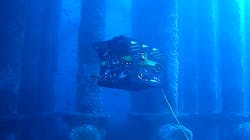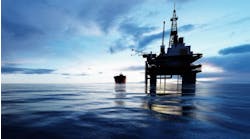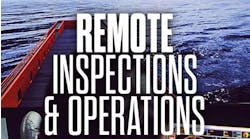Underwater drones to lower subsea inspection costs
Editor's note: This article first appeared in the July-August 2023 issue of Offshore magazine. Click here to view the full issue.
By Craig Cameron, DeepOcean
Placing structures on the seabed has been part of the oil and gas industry’s modus operandi for more than 50 years. As operators moved into deeper waters, subsea production equipment, including pipelines and cables, became the norm. The wind industry started moving offshore in the 1990s, generating a new wave of subsea equipment including wind turbine generator foundations and subsea power cables.
Today, ROVs are primarily used to inspect subsea infrastructure. The ROVs are typically launched from subsea multipurpose vessels for inspection, maintenance and repair (IMR) work and often controlled by specialist ROV operators on board the vessel. Some companies have also developed remote operations capabilities, which allow the company to control the ROV from an onshore-based remote operations center, thereby reducing operating costs, emissions and HSE risk.
Automated inspection
Automating parts of the subsea inspection scope, using a smart ROV, is an obvious next step for the industry. Significant value can be created for E&P companies if these inspections can be automated using a resident ROV or an unmanned surface vehicle (USV) combined with an intelligent ROV platform that is able to execute planned missions autonomously.
It is also likely that combining a smart observation-class ROV with a conventional vessel may create value for E&P companies by increasing the amount of work performed per unit of time. This is particularly true if the ROV is battery-powered and untethered from the mother vessel. This would allow the ROV to leave the mother vessel with one or multiple inspection scopes and return to the vessel after completion.
In the offshore renewables sector, it is even more attractive to automate regular inspection of subsea structures as hundreds of similar structures are installed on a single field development. This means that the same inspection scope can be repeated numerous times before the intelligent ROV platform returns to the mother vessel.
However, until now, no solution has existed capable of carrying out the complex programmed inspection of subsea structures. This is why DeepOcean in recent years has contributed towards the development of an Autonomous Inspection Drone (AID), which is an intelligent observation-class ROV capable of performing programmed inspections of subsea assets.
The AID project is a strategic partnership between DeepOcean, Argus Remote Systems and Vaarst where a system of systems has been developed with industry guidance, support and funding from AkerBP to bring a platform to market.
The AID is based on a Rover MK2 ROV from Argus Remote Systems. Argus is also responsible for AID platform and navigation algorithm. DeepOcean is responsible for the digital twin platform, mission planner software and live view of the AID in operation, while Vaarst is responsible for the machine vision camera for autonomous navigation and data collection. The AID measures 1.25 x 0.85 x 0.77 meters and weighs 320 kilograms in air and can operate in water depths down to 3,000 meters.
Digital twin enabler
A key enabler for the ability to perform programmed, autonomous inspection work is the creation of digital twins of the subsea infrastructure.
A digital twin is a dynamic virtual copy of a physical asset, process, system or environment that looks like and behaves identically to its real-world counterpart. A digital twin ingests data and replicates processes to predict possible performance outcomes and issues that the real-world product might undergo.
To undertake programmed inspection of subsea assets, a digital twin must be developed. DeepOcean has developed digital twins into a software platform where a model of an AID is controlled. This allows inspection engineers to first virtually plan the route for the inspection scope. The planned route in the digital twin is then exported to the AID. Subsequently, the AID can then autonomously execute the planned route, while an operator simultaneously oversees the operation. The inspection data from the AID and the position of the vehicle is continuously being streamed back into the digital twin to ensure high data quality and increase situational awareness for the operator.
First offshore operations
In February 2023, the AID was mobilized on board the Edda Fauna subsea IMR and ROV support vessel for its first offshore operations, at one of DeepOcean’s annual inspection campaigns for an operator on the Norwegian continental shelf.
Remota AS, the joint venture between DeepOcean, Solstad Offshore and Østensjø Group, is enabling offshore operations to be performed from onshore through digitalized control systems. DeepOcean is running the AID from the Remota control center.
Unmanned surface vessels
The AID can play an integral role on conventional vessels, but it can also serve as a key asset for the introduction of USVs carrying out inspections in the ocean space. While both methods are suited to solve subsea inspection tasks, there is no doubt that combining the AID and a USV has higher value creation potential versus utilizing conventional vessels, because of the lower cost and environmental footprint it offers.
Irrespective of the type of vessel platform the AID is launched from, the combination of AID and digital twins for subsea inspection work can save operators of offshore assets a substantial amount of time and money.



